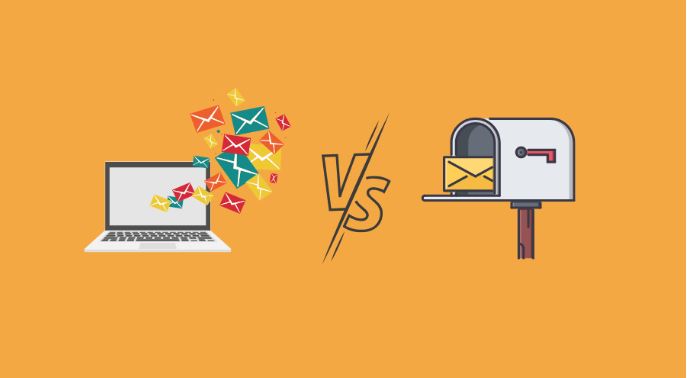The battle between email and direct mail rages on. Both offer unique advantages, but which one truly delivers the knockout punch when it comes to engaging your audience.
Email, the tried-and-true workhorse of communication, has long been a staple in the marketer’s toolkit. With its widespread adoption and ability to reach a broad audience, email campaigns can be an effective way to share your message
direct mail – the more personalized, targeted approach that packs a punch. By leveraging detailed customer data and segmentation, direct mail allows you to craft tailored messages that speak directly to your audience’s needs and interests. This heightened level of relevance can translate into higher open rates, click-throughs, and ultimately, conversions.

What is email marketing?
Email marketing is a structured, strategic form of digital marketing that uses emails to communicate with a targeted audience. It involves sending promotional messages, newsletters, updates, and other types of content to a list of subscribers who have opted in to receive communications from the sender.
For example :
- A monthly newsletter from an e-commerce store featuring new products and special discounts.
- Automated welcome emails to new subscribers with a special offer.
- A drip campaign providing educational content leading up to a product launch.
What is direct mail?
Direct mail refers to the practice of sending unsolicited or cold emails to individuals or businesses, typically for promotional purposes. These emails are sent without prior consent from the recipients, often to purchased or harvested email lists.
For example: postcards, brochures, catalogs or even letters.
Pros and Cons :Email VS Direct mail
By understanding the pros and cons, businesses can leverage email marketing effectively while addressing potential pitfalls to maximize its impact on their marketing efforts.
Email pros:
Cost-Effective: Email marketing is relatively inexpensive compared to traditional marketing channels like print or television ads. It requires minimal investment in tools and resources, making it accessible to businesses of all sizes.
Wide Reach: With billions of email users worldwide, email marketing allows businesses to reach a vast audience instantly. Whether targeting local or global markets, email enables you to connect with potential customers effectively.
Increased Engagement: Emails can include interactive elements such as clickable links, buttons, images, and videos, enhancing engagement and driving actions like website visits, purchases, or sign-ups.
Email cons :
Deliverability Challenges: Email deliverability can be affected by various factors, including spam filters, sender reputation, and email authentication issues. Poor deliverability rates can result in emails landing in spam folders or not reaching recipients at all.
Overload and Clutter: Inboxes are often flooded with promotional emails, leading to email fatigue and reduced attention from recipients. Competition for attention in crowded inboxes makes it challenging for businesses to stand out and capture recipients’ interest.
Limited Visual Impact: Unlike other marketing channels such as social media or video, emails have limitations in terms of visual impact and creativity. Businesses must rely on compelling copywriting, design elements, and strategic use of images to capture recipients’ attention.
Direct mail pros:
Targeted Reach: Direct mail allows you to target specific demographics, geographic locations, or customer segments, increasing the likelihood of reaching your intended audience.
Tangibility: Unlike digital marketing, direct mail provides a physical piece of marketing material that recipients can hold, making it more memorable and potentially more impactful.
Personalization: You can personalize each piece of direct mail with the recipient’s name, address, and even tailored offers or messages, increasing engagement and response rates.
Direct Mail Cons:
Cost: Direct mail can be expensive, especially when factoring in printing, postage, and mailing list acquisition costs. It might not be the most cost-effective option for every business, especially small ones with limited budgets.
Lack of Instantaneousness: Unlike digital marketing, which can reach recipients instantly, direct mail campaigns require time for production, distribution, and response. This delay can hinder time-sensitive promotions or announcements..
Limited Reach: While direct mail can be highly targeted, it may not reach as wide an audience as digital marketing channels, particularly younger demographics who are less likely to engage with physical mail.

5 ways to make Email marketing more effective
Eye-Catching Subject Line: Start with a compelling subject line that grabs the recipient’s attention and entices them to open the email. Use personalization, urgency, curiosity, or a clear benefit to increase open rates.
· Clean and Professional Design:
· Use a clean and professional email template that reflects your brand identity.
- Incorporate white space to improve readability and make the content more visually appealing.
- Choose a consistent color scheme and font style throughout the email for a cohesive look.
- Choosing the appropriate salutation is crucial, as it can impact how the recipient receives your email.
· Visual Elements:
- Include high-quality images, graphics, and videos to enhance visual appeal and break up text.
- Use visuals that are relevant to the content of the email and help convey your message effectively.
- Optimize images for fast loading times and ensure they display correctly across different devices and email clients.
· Compelling Content:
- Craft engaging and relevant content that provides value to the recipient.
- Use concise and compelling copy that communicates your message clearly and persuasively.
- Include a clear call to action (CTA) that prompts the recipient to take the desired action, whether it’s making a purchase, signing up for an event, or visiting your website.
· Clear Branding:
- Ensure that your brand logo and colors are prominently displayed in the email header or footer.
- Use consistent branding elements to reinforce brand recognition and build trust with the recipient.
Lastly, determining the best day to send email newsletters can also boost the full potential of email marketing efforts
Which one is best for your business?
Email is likely the most efficient way to reach a broad audience rapidly without requiring a significant initial investment.
For those with a more substantial budget, direct mail could be an option.
For small businesses, leveraging email drip campaigns with segmented lists could be beneficial.
Combining both approaches is also plausible: using direct mail for special events or promotions while relying on email for regular offers and interactions. Regardless of the marketing channel chosen, it’s essential to remember that personalization can greatly enhance engagement and effectiveness.
How to choose between these two: Email VS direct mail?
Email marketing offers cost-effectiveness, speed, and detailed analytics, while direct mail provides a tangible, memorable experience. A balanced approach using both methods can maximize the effectiveness of your marketing efforts.
The answer lies in your specific marketing goals and the needs of your audience. A well-rounded approach that incorporates both email and direct mail can be a powerful combination, allowing you to reach a wider audience while also delivering personalized, high-impact messages to your most valuable prospects.